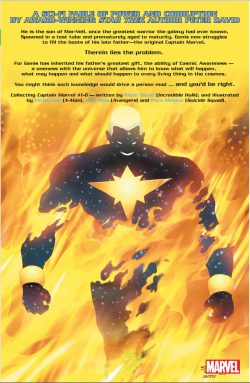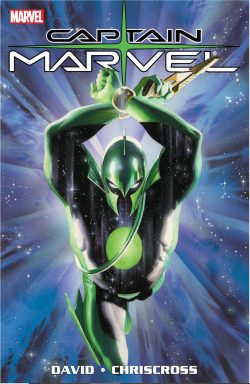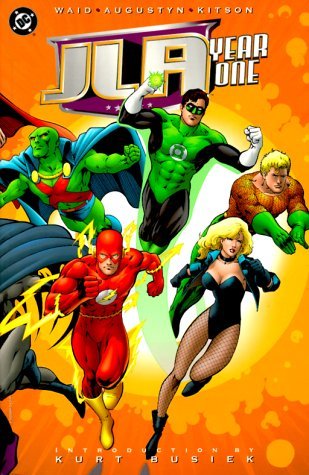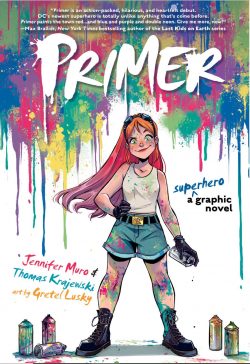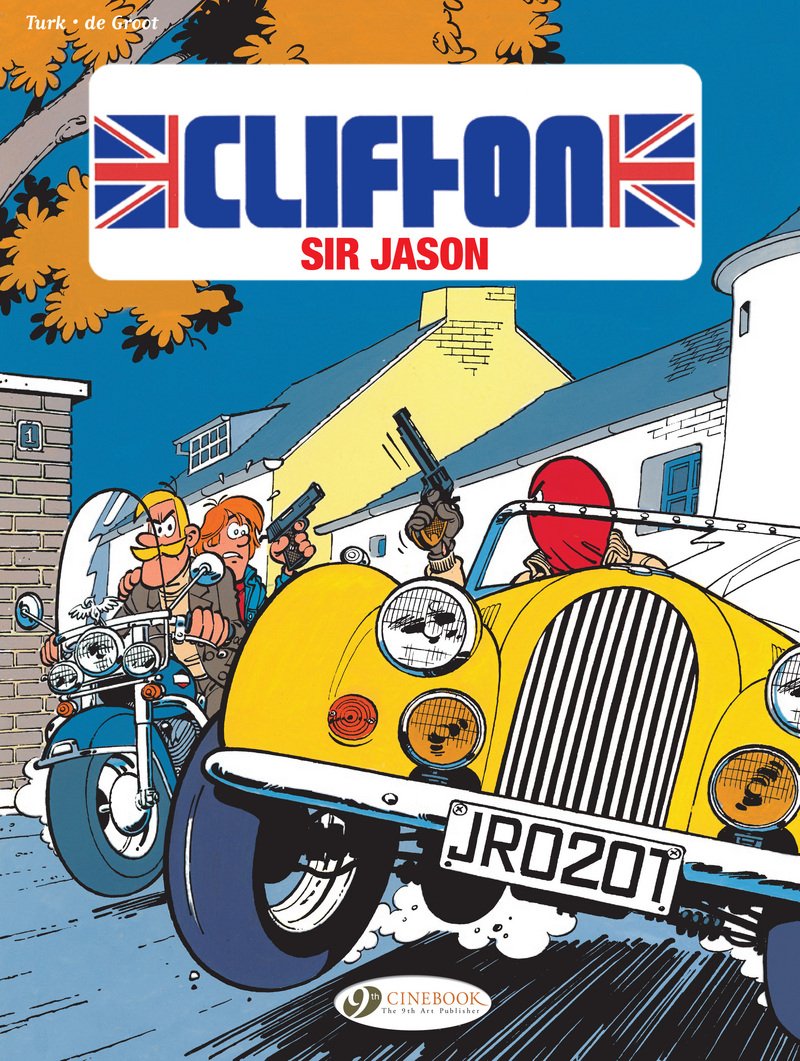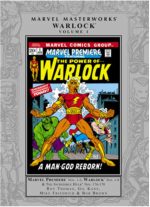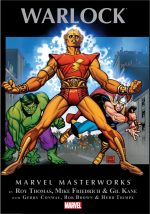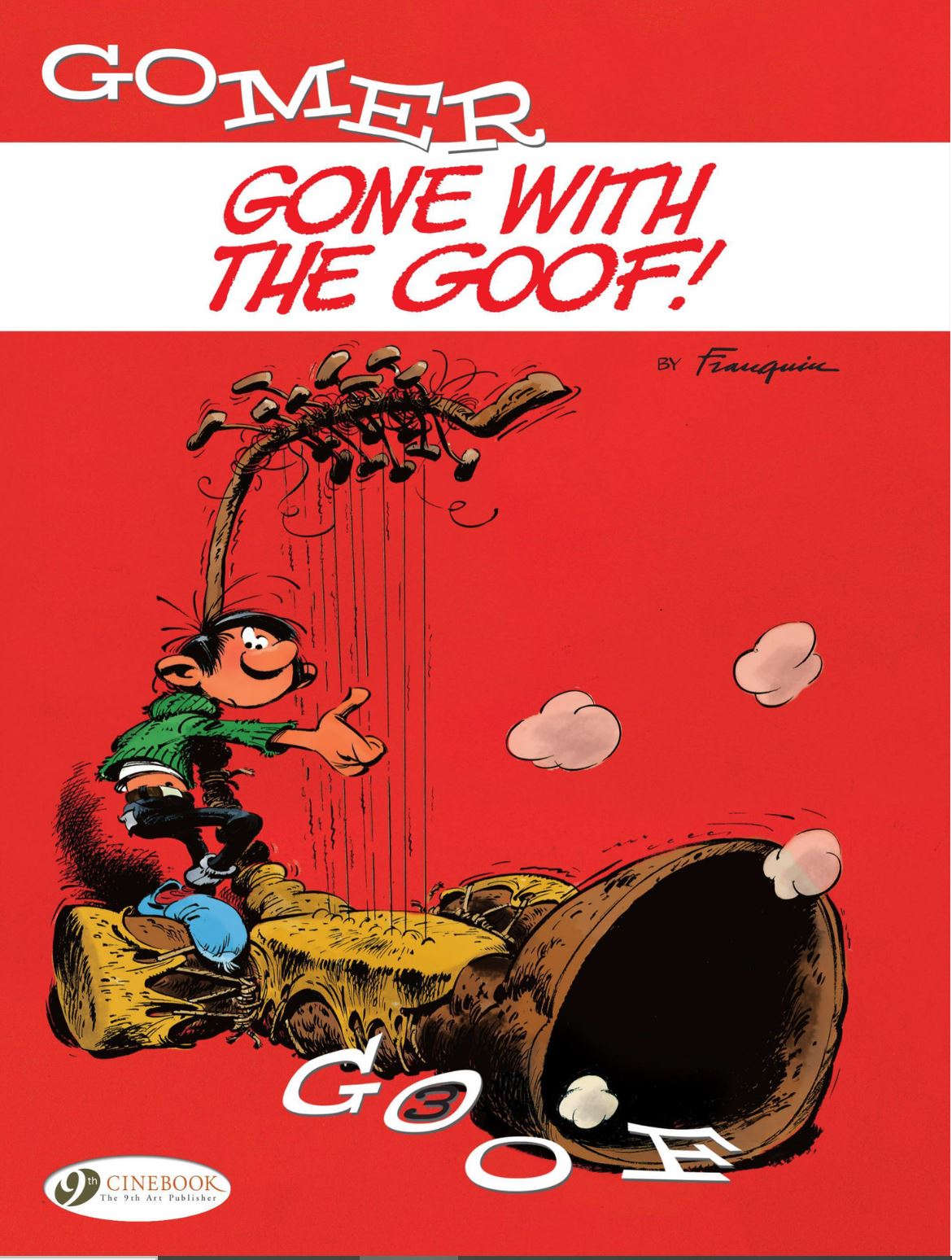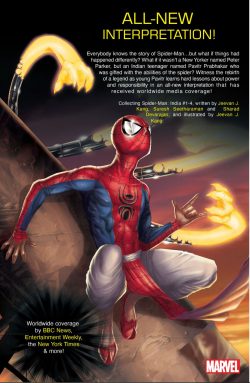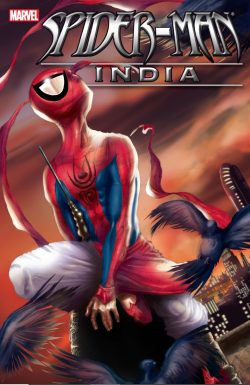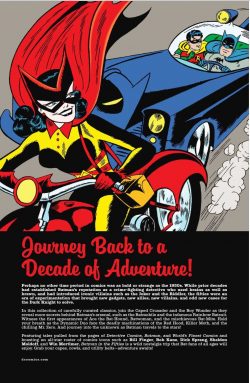
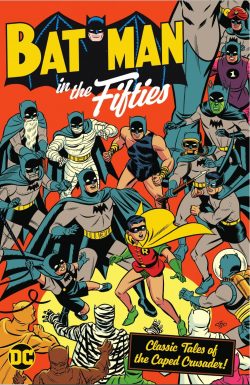
By Bill Finger, Don Cameron, Edmond Hamilton, France Herron, David Vern Reed, Dave Wood, Joe Samachson, Sheldon Moldoff, Dick Sprang, Lew Sayre Schwartz, Bob Kane, Win Mortimer, Charles Paris, Stan Kaye, George Roussos, Ray Burnley & various (DDC Comics)
ISBN: 978-1-7795-0950-5 (TPB/Digital edition)
In the early years of this century, DC launched a series of graphic archives intended to define DC’s top heroes through the decades: delivering magnificent past comic book magic from the Forties to the Seventies via a tantalisingly nostalgic taste of other – arguably better, but certainly different – times. The collections carried the cream of the creative crop, divided into subsections, partitioned by cover galleries, and supplemented by short commentaries; a thoroughly enjoyable introductory reading experience. I prayed for more but was frustrated… until now…
Part of a trade paperback trilogy – the others being Superman and Wonder Woman (thus far, but hopefully Aquaman, Green Arrow and Martian Manhunter are in contention too, as they have become such big shot screen stars these days) – the experiment is being re-run, with even more inviting wonders from the company’s amazing family-friendly canon.
Gathered here is an expanded menu of delights adding to that of the 2002 edition, rerunning Michael Uslan’s original context-stuffed Introduction and chapter text pieces. The stories originated in Detective Comics #156, 165, 168, 180, 185, 187, 215, 216, 233, 235, 236, 241, 244, 252, 267; 269, 1000; Batman #59, 62, 63, 81,92,105, 113, 114, 121, 122, 128; and World’s Finest Comics #68, 81, 89 which span the entire decade while laying the rather bonkers groundwork for the landmark television series of the next decade.
Supported by the first of a series of factual briefings, the comics open with Classic Tales, and ‘The Batmobile of 1950!’ Written by Joe Samachson and illustrated by visionary artist Dick Sprang and ideal inker Stan Kaye, the clever saga of reinvention originated in Detective Comics #156 (cover-dated February 1950 and on sale from December 19th 1949): heralding new vistas as their reliable conveyance is destroyed by cunning crooks.
Badly injured, Batman uses the opportunity to rebuild his ride as moving fortress and crime lab and scores his first techno advance. There would soon be many more: a Batplane II, new boats and subs and even a flying Batcave…
David Vern Reed, Sprang & Charles Paris then set the Crime Crushers to recovering a vital lost tool assemblage before some villain could decipher ‘The Secret of Batman’s Utility Belt!’ (Detective #185 July 1952) and end their careers, after which ‘The True History of Superman and Batman’ (World’s Finest Comics #81, March/April 1956 by Edmond Hamilton, Sprang & Kaye) finds a future historian blackmailing the heroes into restaging their greatest exploits so that his erroneous treatise on them will be accurate…
Foreshadowing modern tastes and tropes, an unknown author & Sheldon Moldoff reveal ‘The New-Model Batman’ in Detective #236 (October 1956) as recently-released criminal genius Wallace Waley deploys counters to all the heroes’ techniques and tech, necessitating a change of M.O and new toys… like a Bat-tank…
In a classic case of misdirection, the Dark Knight briefly becomes ‘The Rainbow Batman!’ in Detective #241 (March 1957). As delivered by Hamilton, Moldoff & Kaye, a series of outlandish costumes keep the public – and reporters’ – gaze on the mighty masked peacock and well away from the biggest story of the decade…
Bill Finger, Moldoff & Paris detail a review of the hero’s most versatile weapon in ‘The 100 Batarangs of Batman!’ (Detective #244 June 1957) as criminals begin using old variants of the throwing tool against him and the Gotham gangbuster has to unleash an almost dangerous and untested prototype to defeat them…
In a most frustrating piece of poor editing, next up is the seminal sequel story to a most important and repercussion-packed yarn. Crafted by Hamilton, Sprang & Kaye, ‘The Club of Heroes’ first appeared in World’s Finest Comics #89 (July/August 1957) reprising an earlier meeting of Batmen from many nations. It became a key plank of Grant Morrison’s latterday epic Batman: the Black Glove as those valiant foreign copycats reconvened to add the Man of Steel to their roster only to find him suffering recurring amnesia and outshone by brand-new costumed champion Lightning Man…
‘The Thousand Deaths of Batman!’ (Detective #269 July 1959) comes from another uncredited scripter, with Moldoff & Paris limning a bizarre tale of a criminal entertainment network offering staged deaths of their greatest enemies until the Caped Crusaders infiltrate and exterminate…
Just as the adventures always got bigger and bolder, so too did the character roster and internal history. The Bat-Family section homes in on the heroes’ constantly expanding supporting cast, and leads with something I just finished whining about.
Detective Comics #215 (January 1955) featured ‘The Batmen of All Nations!’ by Edmond Hamilton, Moldoff & Paris) and saw the World’s Greatest Crimefighters acknowledged as such by well-meaning champions from Italy, England, France, South America and Australia, who took the sincerest form of flattery a step too far by becoming nationally-themed imitations. That was fine until they all attend a convention in Gotham City doomed to disaster after a villain replaces one of them…
Why on Earth did this tale have to follow its own sequel?
Anyway, back to our usual nonsense and a question: Do you believe in coincidence? Superman was incredibly popular throughout the 1950s and many things that happened to him were tried in Batman stories. For a while the caped crusader even had a girl reporter – Vicki Vale – trying to ferret out hi secret identity. So when Adventure Comics #210 (March 1955) introduced a dog from Krypton, how surprising was it that Batman would soon join that rather exclusive kennel club?
For no reason I could possibly speculate upon, ‘Ace the Bat-Hound!’ debuted in Batman #92 (June 1955), created by Bill Finger, Sheldon Moldoff & Charles Paris. Ace was a distinctive German shepherd temporally adopted by Bruce Wayne when his actual owner John Wilker is abducted by crooks. A skilled tracker with distinctive facial markings, the pooch inserts himself into the case repeatedly, forcing the Dynamic Duo to mask him up as they hunt his master and foil a criminal plot. Like Krypto, Ace reappeared intermittently until Wayne stopped borrowing him and just adopted the amazing mutt.
Almost as necessary a Fifties adjunct, ‘The Batwoman!’ debuted in Detective #233 (July 1956) as Hamilton, Moldoff & Kaye added a female copy to the cannon…
Today fans are pretty used to a vast battalion of bat-themed champions haunting Gotham City and its troubled environs, but for the longest time it was just Bruce, Dick Grayson and an occasionally borrowed dog keeping crime on the run. However, three months before the debut of the Flash officially ushered in the Silver Age, editorial powers-that-be introduced valiant heiress Kathy Kane, who incessantly suited-up in chiropteran red and yellow over the next eight years. She was a former circus acrobat who burst into Batman’s life, challenging him to discover her secret identity at the risk of exposing his own…
Far more critical to the growing legend was Finger, Moldoff & Kaye’s ‘The First Batman!’
as originally seen in Detective Comics #235 (September 1956): a key story of this period which introduced a strong psychological component to Batman’s origins, disclosing how when Bruce was still a toddler, his father had clashed with gangsters whilst clad in a fancy dress bat costume…
In Batman #105, (February 1957) France Herron, Moldoff & Paris introduced ‘The Second Boy Wonder!’ as a stranger apparently infiltrates the Batcave by impersonating the kid crimebuster, but there’s more going on than would first appear, unlike Batman #114 (March 1958) wherein unknown writer, Moldoff & Paris reveal how circus gorilla Mogo joins the team to clear his framed keeper’s name in ‘The Bat-Ape!’…
The grim gritty tone of the Dark Knight remains utterly absent in ‘The Marriage of Batman and Batwoman!’ (Batman #122, March 1959) as Finger, Moldoff & Ray Burnley manifest Robin’s bleakest nightmares should such a nuptial event ever occur, before Detective #267 (May 1959) details how ‘Batman Meets Bat-Mite!’ and Finger, Moldoff & Paris launch the Gotham Guardian’s most controversial “partner” – a pestiferous, extra-dimensional prank-playing elf who “helps” his hero by aiding his enemies to extend the duration of the fun… (World’s Finest Comics #68, January/February 1954).
In the 1950s costumed villains faded from view and preference for almost a decade – until the Batman TV show made them stars in their own right. Thus there’s not as big a pool to draw on here as you might expect, and what there is mostly the old favourites..
The Villains highlights our hero’s greatest recurring enemies, leading with The Secret Life of the Catwoman!’ from Batman #62 (December 1950/January 1951) by Finger, with Lew Sayre Schwartz ghosting for Bob Kane – who only pencilled a few faces and figures. It’s all inked by Paris.
Here the Felonious Feline reforms and retires after a head trauma cures all her larcenous tendencies… until Batman begs law-abiding Selina Kyle to suit up once more and go undercover to catch crime boss Mister X.
Kane had all but left his role to others by this time and his contributions remained minor in The Origin of Killer Moth!’ (Batman #62, February/March 1951) as Finger, Sayre Schwartz & Paris record how a recently-released convict steals Batman’s ideas and sets up as a paid costumed crusader for crooks…
Around that time Detective #168 (February 1951) began the long road to an origin for the Joker as Finger, Sayre Schwartz, Kane George Roussos and Win Mortimer exposed ‘The Man Behind the Red Hood!’ This reveals a partial origin as part of a brilliantly engrossing mystery which begins when the Caped Crusader regales eager college criminology students with the story of “the one who got away” – just before the fiend suddenly comes back…
Batman’s most tragic Golden Age foe resurfaced cured and fully functional in Detective #187 (September 1952), but Harvey Dent was soon on a spree committing ‘The Double Crimes of Two-Face!’ (by Don Cameron, Sprang & Paris). Although the Dynamic Duo knew from the start their foe was a fake, the situation was far different two years later when Reed, Sprang & Paris detailed how ‘Two-Face Strikes Again!’ in Batman #81 (February 1954). This time a freak accident restored Dent’s scarred bipolar state and the heroes were outmatched all the way to the stunning turnabout conclusion…
The bit about bad guys bows out with ‘The Ice Crimes of Mr. Zero’ (Batman #121, February 1959) as Dave Wood, Moldoff & Paris depict a scientist’s turn to crime after an experiment afflicts him with a condition that will kill him if his temperature rises above freezing point. Although cured in this yarn, that villain would return, taking the name Mr. Freeze …
Final comics section Tales from Beyond highlights the increasingly strange adventures of the Dynamic Duo which – due to Comics Code embargoes on horror and the supernatural – meant a wealth of weird alien and startling science fiction themes. The wonders beginswith a rarely reprinted yarn from Finger, Sayre Schwartz, Kane & Paris originally seen in Batman #59 (June/July 1950). It begins as the heroes seek to use time travel to cure The Joker, before a mistake by chronal scientist Professor Carter Nichols dumps them in 2050 AD. ‘Batman in the Future!’ finds them aiding the Harlequin of Hate’s crimefighting descendant against space pirates before returning to their own era…
A solid gold classic follows as ‘The Batman of Tomorrow!’ (Detective #216, February 1955) visits the 20th century – from his home in 3054 – to save an injured Bruce Wayne from Vicki Vale’s latest exposé and catch a cunning crook in a fast paced and fantastical romp by Hamilton, Sprang & Paris.
Many of these bright-&-breezy high fantasy tales deeply affected modern writers and the overarching continuity, perhaps none more so than Herron, Sprang & Paris’ ‘Batman – The Superman of Planet X!’ from Batman #113 (February 1958): which formed a key thematic plank of Grant Morrison’s epic 2008 storyline Batman R.I.P. The story details how the Gotham Guardian is shanghaied to distant world Zur-En-Arrh by its version of Batman to fight an alien invasion: a task rendered relatively simple since the planet’s atmosphere and gravity gives Earthmen incredible superpowers…
In Detective #252 (February 1958) Wood, Moldoff & Paris channelled contemporary film fashion as a monster makes trouble on a movie location shoot, compelling the costumed champions to tackle ‘The Creature from the Green Lagoon!’ before the last tale in this section – and volume – reveals how our heroes mistakenly aid an alien pirate and are arrested and imprisoned offworld by interstellar lawmen. ‘The Interplanetary Batman!’ (Batman #128. December 1959) is a riotous rollercoaster rocket ride by Finger & Moldoff with Batman and Robin overcoming all odds to clear their names and get home and is a perfect place to pause this circus of ancient delights.
Also including a selection of breathtaking covers and a ‘Bonus Cover Gallery’ by Sprang, Mortimer, Moldoff, Curt Swan, Sayre Schwartz, Kaye & Paris, this is a splendidly refreshing, comfortingly compelling and utterly charming slice of comics history that any aged fan or newcomer will delight in: a primer into the ultimate icon of Justice and fair play.
© 1950, 1951, 1952, 1954, 1955, 1956, 1957, 1958, 1959, 2002, 2019, 2021 DC Comics. All Rights Reserved.

